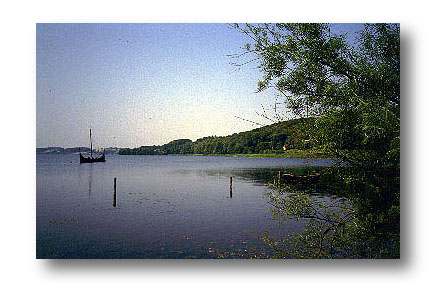|
Most of the fly-fisher's insects hatched
in May and June, which may make the rivers seem relatively dead
over the summer. However, the fish are still there, and they
certainly still feed. The difference is that this takes place
near the bottom instead.

- July can be a good month
for perch that just love the heat of summer!
- © photo: Steen
Ulnits
In freshwater
Or the fish focus on the land insects that
might fall or be blown into the water by mistake. A fatal mistake,
as the fish are usually there like a shot during the summer months,
where food is less abundant.
If the summer is wet and cold, July may
offer really god sea trout fishing in the rivers. So good that
it is not a rare thing for the biggest catch of the year to be
made here - newly ascended, bulging and silvery, after a nourishing
stay in the plentiful larder of the sea.
This was especially the case in the fantastic
summer of 1998. A summer which yielded more and bigger ascending
fish than are normally seen. And this was all due to the water
that happened to come down at an unusual time.
If you meet these fresh ascending fish,
you are almost guaranteed that they will rise to your bait. They
are not at all difficult. provided they have been in freshwater
for only a few days. Then they still have the reflex to rise,
but if they have spent just a week in the river, they become
much more difficult to lure.
In saltwater
If you are on holiday by the sea and the
beach, there are excellent opportunities of making contact with
the cod all through the summer. By July the coastal waters have
become a little too warm for them, and they will move out to
slightly deeper waters. Here they are usually not difficult to
find at depths between 5 and 15 metres - usually where a little
current refreshes the water - and usually over a hard bottom.
The flatfish have now also gained some
weight after the spring breeding, and this makes them an attractive
prey - and a great delicacy in the kitchen. Flounders, dabs and
not least plaice will also move to deeper waters as the summer
heat increases. If you can find a spot with a purely sandy bottom,
you are almost guaranteed a helping of plaice on a hand line.
If you have access to a boat , there is
a good chance of encountering mackerel in deeper waters at the
end of July - if the weather behaves, that is. Mackerel do not
like to get sand in their gills, as their gill rakers are too
fine-meshed. However, if you come after a few days of good weather
and calm winds, the water is usually clear, and then a shoal
of mackerel may come rushing by at any time.
The chances of meeting mackerel increase
during the month of July and peak sometime in August. So there
is something to look forward to and wait for!
© Steen Ulnits
|

